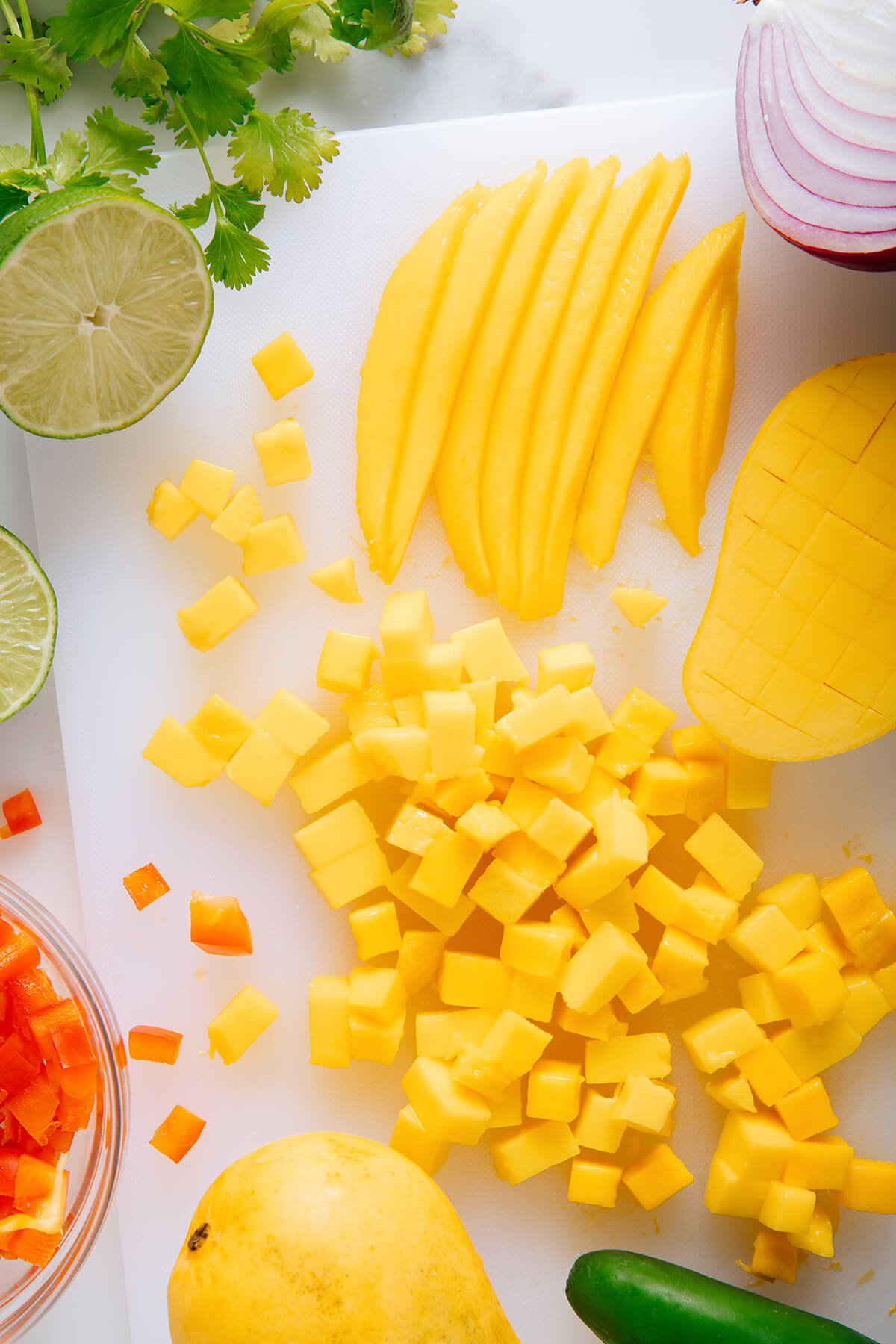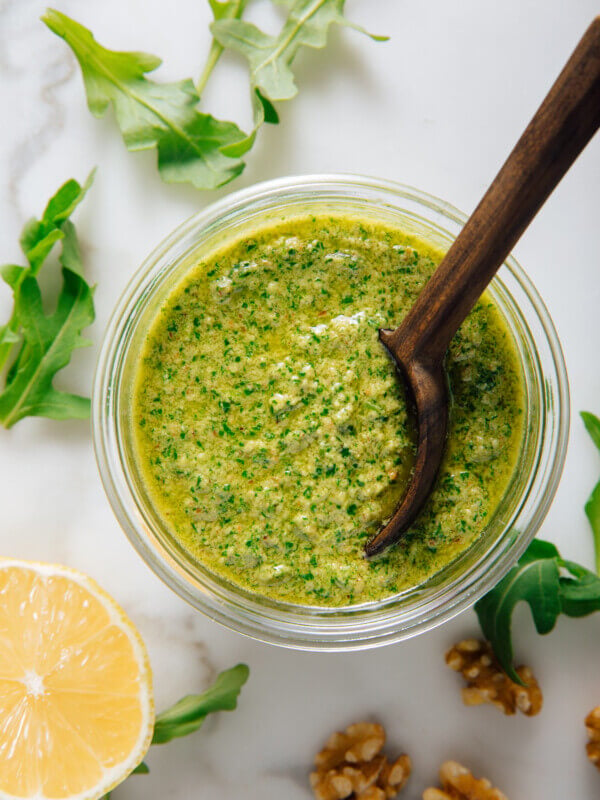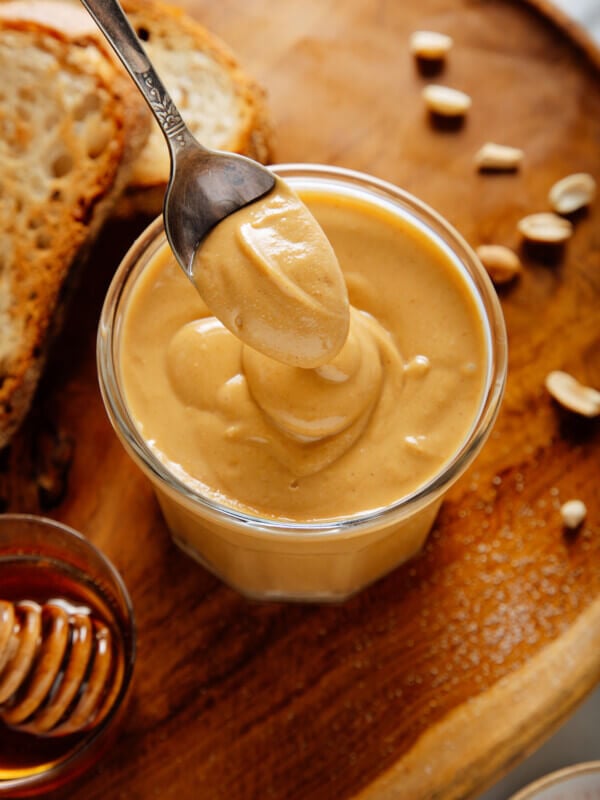How to Cut a Mango
Learn how to slice or dice mango! It's easy once you know this method. You'll find selection tips, step-by-step photos and a video here.
Posted by Kathryne Taylor on May 6, 2025

Mango season is here! I’m celebrating with a guide to preparing mango, whether you want it sliced or diced. Mango is one of the most popular fruits in the world, but I didn’t grow up eating it and had to learn how to prepare it. I’ve tried all the different methods, and I’m sharing the best way to cut mango today.
Mango tastes sort of like a juicy tropical peach, with notes of honey. Even when it’s ripe, it typically has a light sourness to it, which keeps me going back for more. I love using mango for a burst of sweetness in salads, salsa, and savory entrées—not to mention snacking on them.
Mangoes are at their peak in the summer, typically available from May through September. I’ve been excited to find Ataulfo mangoes (also known as honey or Champagne) on sale at Whole Foods lately. That’s the variety you see here, and they’re particularly buttery and delicious. My preparation methods will work well on any variety and size of mango!


Mango Preparation Tips
How to Tell if a Mango is Ripe
Look for mangos that yield slightly to a gentle squeeze, like a ripe avocado or peach would. It should have a vibrant color, which varies depending on the variety, and smell sweet on the stem end.
Underripe mangoes will be very hard. Avoid overripe mangoes with wrinkled skin or brown spots—they tend to be extra sweet, but with a more stringy and mushy texture inside.
Watch How to Prepare Mango
You’ll find written instructions in the recipe at the bottom of the post. For visuals, check out this brief video:
Note on Mango Skin
If you’re wondering, “Can I just eat mango skin?” the answer is technically yes, but you might not want to. Mango skin contains fiber and nutrients, though I’ve heard it’s not very tasty.
Mango skin can be irritating to human skin because it contains urushiol, which is the same compound found in poison ivy that can cause contact dermatitis. As someone with sensitive skin, I’m careful not to eat mango right off the skin.


How to Serve Fresh Mango
Ripe mango is a delicious snack on its own. I love it with a sprinkle of chili-lime seasoning like Tajín, which offers some salty spiciness to balance the sweetness.
You can freeze diced mango for smoothies, or simply to preserve a surplus. To prevent the pieces from sticking together, place the mango on a parchment paper-lined pan, freeze until solid, then transfer it to a freezer bag.
Mango goes particularly well with ingredients like black beans, berries, chili peppers, cilantro, coconut, ginger, lime, mint, red onion, peanuts, pineapple and yogurt. Many of those ingredients are incorporated in the recipes below.
Recipes with Fresh Mango
Here are a few recipes featuring mango on Cookie and Kate. You’ll see that I love to combine sweet mango with savory and spicy flavors for balance:
- Fresh Mango Salsa
- Mango “Burrito” Bowls with Crispy Tofu and Peanut Sauce
- Thai Mango Cabbage Wraps with Crispy Tofu and Peanut Sauce
- Thai Mango Salad with Peanut Dressing
- Tropical Mango Spring Rolls with Avocado-Cilantro Dipping Sauce
Please let me know how this method works for you in the comments. I love hearing from you.

How to Cut a Mango
Learn how to slice or dice a mango! It’s easy once you know this method. Prepare as many mangos as you need, and see the recipe notes for freezing instructions.
Ingredients
- 1 ripe mango
Instructions
- With one hand, hold the mango upright with the stem on top. Use a sharp chef’s knife to slice off one wide side of the mango, about ½-inch from the center (if you hit something hard or hear a scratching sound, you’re too close to the pit and need to slice further from the center). Then, slice off the other side in the same fashion.
- Working with one piece at a time, gently use your knife to slice through the flesh (don’t press so hard that you cut the skin). To make sliced mango, slice long, narrow vertical cuts. To make diced mango, make wider vertical cuts followed by horizontal cuts to make a grid pattern. You can likely slice more flesh off each side of the pit and score it as well.
- Use a large spoon to scoop the flesh from the skin, then use your slices or cubes as desired. If your mango was large, you might be able to slice a bit more flesh from around the pit, though the pieces won’t be uniform like the rest—they’re good for snacking!
Notes
To freeze leftover mango: Place the mango on a parchment paper-lined pan that will fit into your freezer. Freeze until the mango is solid, then transfer it to a freezer bag.














The salads look spectacular! I can hardly wait to make and eat! Thank you!!!
I have been having a hard time with Mango’s. I think this will make it easier for me.Thank you
Hi Judy, I’m so glad you find it useful.
As someone who has spent just a little time in Central America, namely El Salvador, I would argue that mango season is more like March to June! Here in the northern regions of Canada where I live now, gorgeous, delicious mangos have been available for the last month or 2!
For years I’ve been using a dedicated mango pit remover combined with the “glass trick,” which maximizes the amount of fruit vailable and eliminates the need to deal with the skin or to have to use large knives at all. The mango pit remover is widely available, with dozens of slightly different versions available on Amazon. Be sure to use ripe but not overripe fruit, just as Kate describes. The “glass trick” (which works equally well on avocados) is simple once you get the hang of it–use the pit remover to break the mango down into the two sides plus the pit and its surrounding fruit, then hold pretty much any kind of relatively thin-rimmed strong water glass, including hard plastic versions as long as they have a thin rim, against the edge of the section, “between” the skin and fruit (hold the section in your non-dominant hand, and the glass in your dominant hand). A firm push with the glass firmly between the skin and fruit should remove the fruit completely from the skin and leave the fruit in the glass, that is, unless the fruit section is much wider than the glass in which case you may need to do it twice. For safety you could instead use a thin rimmed plastic glass. In years of doing this I’ve never come close to breaking a glass but I certanly support the plastic glass precaution. The glass trick is also widely shown on YouTube so if my description is lacking please do search it there–that will show you how to do exactly what I’m describing. Tip–if your mango has a “red end” and a “green end,” start the glass pushing the section on the green end–mangos are assymetrical on the long axis–the fruit cut in one direction tends to be smooth, but the fruit cut in the other (red) direction is usually somewhat stringy. You can then remove the remaining skin from each end of the pit section with a paring knife, and use a larger knife to slice downwared on the sides of the pit where there is still a lot of nice fruit remaining. Once you have the two sections and the pit slices you can do just as Kate says, slice or dice at will. The combination of pit remover and glass trick took my mango experience from being challenging, tedious at best, and made it quick and simple with lots of nice fruit to show for it very quickly. It works very well on ripe but not overripe avocados but you’ll need to slice down the side of the pit on both sides, remove the pit, then do the glass trick–all ready to slice for sandwiches or salads or to make guacamole. Sorry if I used too much space here–I’ve been following C&K for many years and I’ve made lots of the duo’s recipes. Keep them coming, from a true fan!
Where’s the video??
Hi Molly, the video in embedded beneath the “Watch How to Prepare Mango” heading.
I looked all over that heading, and clicked several places but could not find the video.
Not to knock your method, but I have found that the EASIEST way to cut a mango is to first peel the skin with a potato peeler, it’s very easy to peel and leaves you with the most mango to then cut off from around the pit. I’ll admit, this method is a little messier/slimier, but works great.
Dear Katherine, Hi. I enjoy so many of your recipes and it is a blessing and so generous that you share them with us. Also, I appreciate the accessibility and ease with which they are available to be added to our recipe collection or printed and tucked into my copy of your book. I am mostly on a plant fit diet and I find it easy to make slight adjustments to most of your recipes when I wish to reduce or alter some ingredients.
Thank you for your wonderful contribution to ‘fine eating’ and easy creations.
Pnina